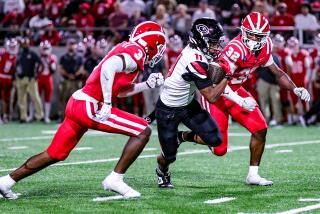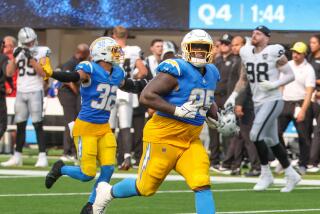NFL DRAFT PREVIEW : Big Prize: Defensive Linemen : They Need Quickness, Determination; Size Helps
Several weeks before the Raiders drafted Howie Long in 1981, Coach Tom Flores went out of his way to meet him, walking across a practice field to shake Long’s hand.
“That was a friendly thing to do, Tom,” a bystander said when Flores came back.
“Friendly, hell,” Flores said grimly. “I was just testing his grip. We’re looking for a pass rusher.”
To rush passes, defensive linemen must first defeat offensive linemen. And that, Flores said, takes long arms and big, strong, tough hands.
“Hands like Howie’s,” he added.
What else does it take?
How do you find a defensive lineman? How did the pros evaluate the defensive ends and tackles who came up for the draft this week?
It’s not easy.
Grading these people isn’t like grading halfbacks, receivers or even cornerbacks.
There are several ways to measure receivers, for instance, from catches to yards to touchdowns.
But how do you measure a defensive lineman?
“You don’t,” said the New England Patriots’ chief scout, Dick Steinberg. “I mean, there are more surprises and more scouting errors--more busts--in the defensive line than at any other position. It’s hard to be sure about the best of them.”
On a football team, nonetheless, no defensive player is more valuable than a good pass rusher. Every club in the NFL wants at least one more, and preferably two or three.
Therefore, when scouting the country, most clubs study defensive line prospects at least as carefully as--and usually at greater length than--candidates for other positions.
These are the areas of consideration:
SIZE, SPEED
This is the easy one, except for the Raiders, who must have height as well as heft. The taller the better.
“That’s the first thing we look for,” Flores said. “The prototype now is 6-5.”
Raider owner Al Davis’ view is that giants intimidate opponents. Long is 6-5 and 270. Lyle Alzado, 6-3 and 260, has been succeeded by Sean Jones, who is 6-7 and 270.
“Today’s minimum weight (for a defensive lineman) is 260,” Flores said.
The Denver Broncos have also become more size-conscious lately under Coach Dan Reeves.
“The most obvious trend in football these days is that the offensive linemen are getting bigger,” Reeves said. “They are 290 and 300 now. And (the Broncos) have been facing them with one of the smallest defensive lines in the league. We’ve got to do something about that.”
Without sacrificing foot speed.
“The two easiest things to see are size and speed,” Reeves said.
ACCELERATION When an NFL scout talks about athletic talent in the defensive line, he means primarily three things: a player’s ability to accelerate and to react rapidly, plus his physical coordination.
“Initial quickness--the gift of being able to accelerate right now--is the principal athletic trait a defensive lineman needs,” Steinberg said. “If the blocker is quick enough to get two hands on the pass rusher’s letters and get his elbows locked on him, forget it. Your guy will never get to the quarterback.”
There are a couple of ways to measure such quickness.
“You put a clock on every (defensive line candidate),” Flores said. “You time them in the five-yard sprint.”
Said Steinberg: “You also use your peripheral vision. When the (college) team is practicing, you watch both the ball and the defensive lineman. As soon as it moves, he’d better start moving. You make a mental note of how long it takes him to react.”
Steinberg discerns a subtle distinction between quickness and reaction.
“It’s possible to be quick, per se, and still react rather sluggishly,” he said. “A prospect can have size, speed and quickness--as measured by his time in the five-yard dash--and still not get off with the ball. If he doesn’t, he probably has a reaction deficiency.”
No coach needs that.
COORDINATION
The initial quickness to get around a big offensive lineman is only a part of the physical requirement.
“It’s the essential, but it isn’t enough,” Steinberg said. “The rest is physical coordination. A guy has to coordinate the action of his hands, feet and body as he rushes in. The offensive lineman will retreat and try to lock him up.”
It is during his duels with the offensive lineman that the scouts measure a pass rusher’s physical coordination.
“What you look for is whether the defensive lineman’s feet come to a complete stop,” Steinberg said. “You want him to churn his feet, everlastingly, and at the same time keep moving (toward the passer) as he fights off the blocker with his hands.”
Football people often mention leverage when discussing defensive coordination.
Ron Wolf, chief scout of the Raiders, said: “(Former Raider linebacker) Ted Hendricks seemed too tall and thin for the job. The Hendricks secret was his great leverage. His upper body was so strong that he could control any blocker with his hands as he rushed the quarterback.”
That wasn’t so obvious when Hendricks was in college. Indeed, to Reeves, scouting college defensive players is like reading a mystery story.
“When you watch in a game or even on film, the complication is that you don’t know their team’s defensive scheme,” he said. “They may only look uncoordinated. They may be doing exactly what their coaches want them to do.”
Accordingly, any judgment about a pass rusher’s skills must remain subjective until after he puts on a pro uniform--and sometimes even then.
COMPETITIVENESS
When a pro scout satisfies his inner self that a college player has the raw talent to play in an NFL defensive line, he looks to the player’s attitude.
Attitude is more important than ability, Steinberg said, adding: “The single most important football quality is competitiveness. Film studies show that (it) determines far more sacks than skill or anything else.
“You get more sacks if you just keep coming--if you never give up--than if you have the best moves and techniques in the league.”
How can competitiveness be measured in a pass rusher who seems to be technically superb?
“You can’t measure it scientifically,” Steinberg said. “But game movies can sometimes put you on the right track--if you concentrate on one man while breaking down three or four films. What you do is count the number of plays and big plays he makes--third-down plays, plays on the goal line, sacks, near sacks, and so on.
“Next, if you’re still interested, you send four scouts to see him in four different games. If they (independently) grade him similarly on competitiveness, you may have a pretty good idea.”
At Denver, Reeves tells Bronco scouts to test a prospect’s competitiveness when his team practices, not on game day.
“The best defensive linemen have a mean streak,” he said. “They want to get after people, and you find out about that at practice. The defensive end we want is the guy who is mean on the practice field, who’ll get after his own teammates.”
San Diego Coach Don Coryell is of the opinion that intensive research is turning up meaner defensive linemen every year.
Coryell, whose biggest job is keeping quarterback Dan Fouts upright and healthy, said: “The most troubling trend in football today is the all-out rush to hit the passer after he has thrown the ball. A lot of these guys would rather hit a quarterback late than sack him.
“We see more of it all the time,” Coryell said.
NFL TOUGHNESS
Even though a player has proven that he has the required skills and competitiveness to succeed on a college football field, there is no guarantee that he can transfer them to the NFL.
Drafting a defensive lineman is almost always a gamble, Steinberg said.
“There’s a big difference between NFL toughness and being tough enough to play well on a good college team,” he said. “Some guys won’t fight as hard against big, strong pros as they did against college players. They lose their competitive desire.
“A defensive end who keeps coming on a college team--who won’t be denied--usually gets a payoff, a sack. But on a pro team, against the more clever big man who is blocking him, he may only get a draw, no matter how hard he tries. This discourages a lot of good young defensive linemen. It seems strange, considering their size and speed, but some of them can’t take it.”
They can’t adjust, in other words, to a tougher world.
“That’s why there are so many busts in the defensive line,” Steinberg said. “A guy who seems to have everything, including fierce competitiveness, will fail anyway. On the pro level, he isn’t really fierce.”
How do the pros scout for NFL fierceness?
“The only thing you can do is send every scout you have to see him at different times (during his college career),” Steinberg said. “If they all give him high marks, you roll the dice and draft him.”
For pro clubs focusing on defensive prospects, the year-end all-star games have been particularly happy hunting grounds.
“A good bet is a pass rusher from a small college who stands out in an all-star game,” Steinberg said. “He’s a guy who relishes the better competition.”
A local example is Long, whose Villanova team, in Long’s era, wasn’t exactly a candidate for the national championship. Yet in the 1980 Blue-Gray game, Long was the defensive MVP.
“That was a clue,” the Raiders’ Wolf said. “You look for clues.”
INSIDE POWER
If a prospect doesn’t do it as a pass rusher, can he still succeed in the NFL as a defensive tackle or nose tackle?
Most NFL teams today play the 3-4 defense--three linemen and four linebackers--at least on first down.
Until recent years, in the 4-3 defense, the pros usually used two tackles between two ends. But today, normally, it’s one tackle between two ends--but not necessarily because one tackle is better than two.
Said Steinberg: “The reason is that there aren’t as many good defensive linemen as there are good linebackers. In a 28-team league, there simply aren’t enough defensive linemen to go around.”
Few 1980s pro clubs have been able to recruit more than two first-class pass rushers, and the best they have are always stationed at defensive end.
Teams have a place, however, for another kind of player in their defensive lines: power players.
In a 3-4 lineup, they are called nose tackles. On a 4-3 team, they’re defensive tackles.
“The function of a tackle or nose tackle is to make life easier for his defensive ends,” Steinberg said. “Tackles use their power to control the middle of the line. This frees the ends to rush the passer.”
It’s easier to scout inside power players than outside rushers. That is one reason Oklahoma nose tackle Tony Casillas is this year’s most highly prized defensive lineman. He’s more of a known quantity than the outside rushers.
“Ends have to have it all,” Steinberg said. “A defensive tackle is different. He’s a guy who lacks the burst to rush a passer but still has the size and strength to push guys around on the line of scrimmage--to penetrate. A tackle’s biggest job is to create lanes for the outside guys to run in as they rush the passer.”
The scouts hunt pass rushers first. When they find a defensive-line prospect who can do everything but rush the passer, they call him a nose tackle.
Said Reeves: “Every big nose tackle who can hold his ground in a college line will be drafted this week.”
There is more demand for only one other group--pass rushers.
More to Read
Go beyond the scoreboard
Get the latest on L.A.'s teams in the daily Sports Report newsletter.
You may occasionally receive promotional content from the Los Angeles Times.










